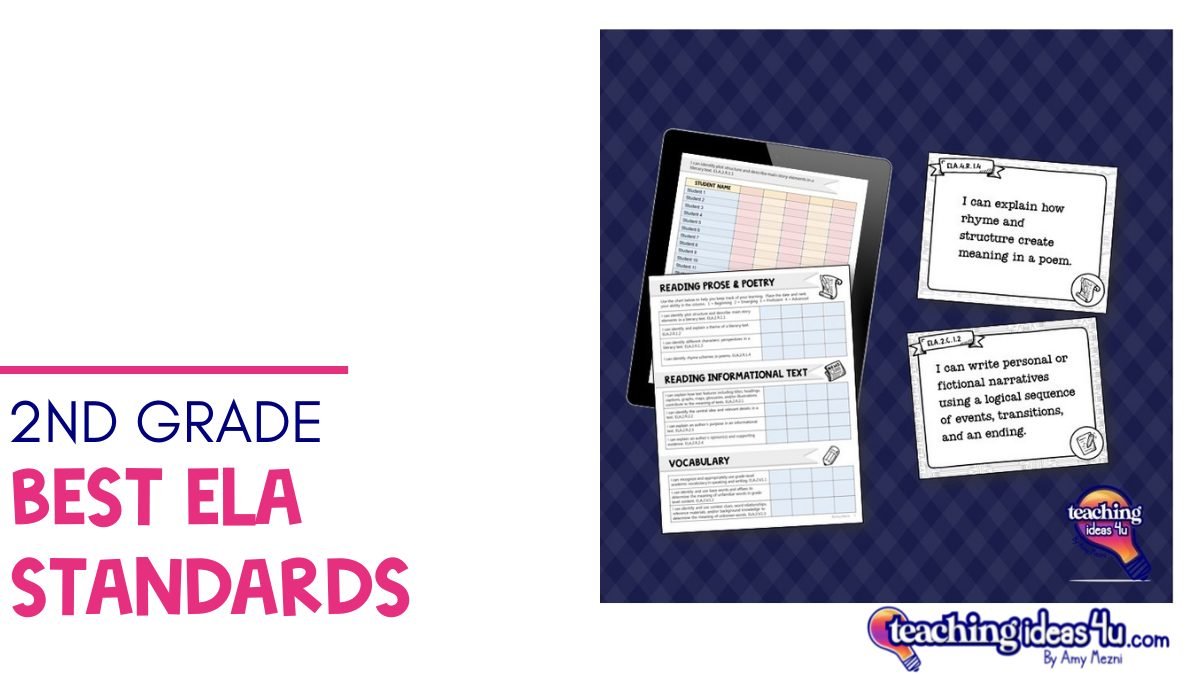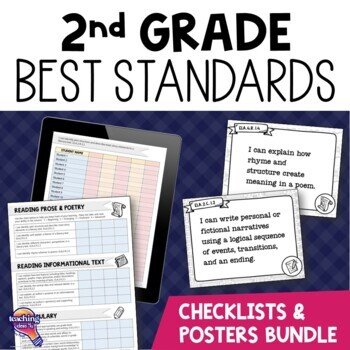2nd Grade ELA BEST Standards
What can second-grade teachers expect from the new Florida BEST Standards for language arts? How do they compare to the LAFS standards? What are second-grade students now expected to learn?
Set your mind at ease, because I am going to break down the new second-grade ELA BEST standards. In this post, I will quickly analyze the changes and how they will affect your classroom.
How are the BEST Standards organized?
BEST standards are divided into 11 subcategories, while the LAFS had 7:
Reading Prose & Poetry - Previously Reading: Literature
Reading Informational Text
Reading Genres – I really don’t understand this category. It includes standards that were previously included with either Literature or Informational Text.
Vocabulary – These standards were in Reading and Language subcategories in LAFS.
Foundational Skills
Oral Communication – Previously Speaking & Listening
Writing
Researching – These were in LAFS Writing.
Technology – These were in Writing and Speaking and Listening.
Conventions – Language
ELA Expectations – I believe these are meant to be similar to the LAFS Reading standards, which were overarching from K!2. However, they don’t work the same way. More on this later.
The BEST standards also include suggested books for each grade level. I will discuss these book lists in detail later in this post.
The Changes
Reading
I have good news: second grade Reading does not significantly change. Overall, once you analyze all the standards in the different categories, nearly all the second grade LAFS reading standards are in the ELA BEST standards. The exception is LAFS.2.RI.1.3 and LAFS.2.RL.1.3. Those standards dealt with describing the connection between a series of events or ideas or describing how characters respond to major events in a story. These were removed.
There is a specific poetry standard in each grade level, which I think is an improvement over LAFS. In second, it is “Identify rhyme schemes in poems.”
Writing
The other good news is that the Writing standards are largely the same. (However, writing is where I would have liked to have seen reform in the new standards.) The only major change in writing is the narrative standard no longer asks students to retell a short sequence of events, but it specifically states “write a personal or fictional narrative.” If students write a personal narrative, they are basically retelling a series of events, so I do not consider this a big change. (Research has been separated into its own category – see below.)
Technology
There are now separate Technology standards, which I think is a good thing. In second grade, there are only two BEST standards in this category. One is basically the same as LAFS.2.W.2.6 – using digital tools to produce and publish writing. The other is “use one or more multimedia element(s) to enhance oral or written tasks.”
Researching
The Researching standard in BEST is a little more specific. In LAFS Writing, it was a pretty general standard: “Students will participate in shared research and writing projects. Recall information from experiences or gather information from provided sources to answer a question.” That standard now says, “Students will participate in research to gather information to answer a question about a single topic using multiple sources.”
Oral Communications
Speaking and Listening skills have been nearly eliminated in grades 2 – 6. As a teacher, I found many kids often struggled with these skills. Oral Communications seems to be stripped down to only focus on presenting information. However, teachers can easily continue to work on these oral communication skills in their classroom as part of other lessons.
Foundational Skills
So, phonics is my weak area, but there are a lot of changes in this section. What stays the same:
Decode words with variable vowel teams (oo, ea, etc.) and vowel diphthongs (oi, oy, etc.)
Decode regularly spelled two-syllable words with long and short vowels. (Short vowels appears to be new.)
Decode words with common prefixes and suffixes.
Read grade-level texts with accuracy, automaticity, and prosody (rhythm and sound) or expression.
What’s new:
Decode words with open and closed syllables and the consonant -le.
Decode words with silent letter combinations.
These skills were removed from the standards:
Long and short vowel in regularly spelled one-syllable words.
Words with inconsistent but common spelling-sound correspondences.
Read with purpose and understanding. (Okay, to me, this is always implied as the goal of reading.)
Use context to confirm or self-correct word recognition and understanding, rereading as necessary.
ELA Expectations
Let me begin with saying I don’t think the expectations themselves are a problem. My concern is the lack of connection between the ELA Expectations and the rest of the standards.
In CCSS and LAFS Reading, the overarching reading standards are the foundations for the rest of the reading standards. For example, Standard 1 deals with making inferences. In every grade level, reading standard 1 deals with inferences – the expectations increase a step in difficulty as the student moves through school.
In ELA BEST, there is no connection that I can find. In fact, there seems to be a disconnect between the two. In the ELA Expectations, it asks students to make inferences. I did not see inference mentioned in any other standards – it is just randomly in this general section without having specific inference goals at each grade level.
Teachers need to be aware of this change, as before the general reading standards really weren’t new skills, but rather the overarching skills. The specific subskill was explained in Literature and Informational Text. Teachers need to make sure they are covering the standards in this subsection.
Conventions
Let me begin with this: I don’t think I can name one language arts teacher that believes students are learning grammar effectively. My brother teaches high school, and he told me they just expect students to not know any grammar or write well. Now, I know I taught grammar in elementary, and so did my teammates. The reality is that kids aren’t learning it. So, this is one area that could be improved.
Unfortunately, I cannot figure out the reasoning behind Conventions in the BEST standards at all. There is no obvious progression as to what is taught in each grade. In fact, the new standards in second grade were formerly standards in grades 1, 2, 3, 4, and 5. There is very little carryover from LAFS to BEST. (For this reason, I am not detailing all the changes here.)
I looked at Kindergarten and first grade to get a sense of what students should know before entering second. The LAFS Language focused heavily on basic skills (end punctuation, capitalization, and parts of speech.) The new standards mention them, but they appear to be a mix of basic and advanced skills.
Conventions standards are all over in every elementary grade. Unfortunately, I think teachers are going to have to use standards in this subsection loosely and instead base instruction on students’ skills and needs (which is what should be happening anyway.)
Book Lists
The state had the idea of including book lists at each grade level for fiction and nonfiction, as well as poems and civics books. Although this idea had potential, the execution has some problems.
I spoke with my teacher friends, and it seems like the lists are suggested and not mandatory. That’s a good thing, because many of the suggested books are out of print.
In second grade, the books are on grade level, so teachers may find some ideas for their class. Other grade levels have some books that are above grade level, but second grade does not. However, there are no below-grade level books, when we know we have students at all levels.
Takeaways
In reading and writing, second-grade teachers can largely continue teaching what they have in the past and meet the standards without a problem. If they continue using their previous materials, they will meet the standards, as well as continue to include higher-level thinking skills.
Teachers should easily be able to include the Oral Communication, Technology, and Research standards in lessons.
Primary teachers will have to focus on their students’ ability levels to teach Foundational Skills and Conventions, as the grade level standards may or may not match their skills. Teachers should assess individual needs and pulling students for small group instruction.
The book lists may give you some ideas, but you may have a hard time finding books because many are out-of-print.
Standards Resources
My standards posters and checklists are being updated (and improved!) If you previously purchased my Florida Standards resources, you get the updates for free – just check your My Purchases area in TPT.


